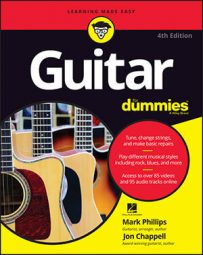If you have limited funds, start out with a practice amp — one that has a decent feature set (tone controls, reverb, and two or more volume controls so you can sculpt your distorted sound) and that delivers a good sound but at low volumes (5 to 25 watts is typical on practice amps). This type of starter amp accustoms you to hearing the electric guitar as it's designed to be heard — through a guitar amp.
Practice amps can run as little as $100 and boast features that appear on their higher-priced performance counterparts. With amplifiers, power — not features — is what drives up the price. Power is expensive to build, requiring heavy-duty transformers, speakers, and cabinetry. For home and casual use, such as jamming with a couple of friends in a garage or basement, 15 or 20 watts is often plenty loud enough, and 5 to 25 watts is sufficient for solo practicing and playing along with your sound system.
On the other hand, features, such as tone controls and effects (like reverb and tremolo), are easier to implement because the manufacturers can stamp them onto a chip and install it on a circuit board. Following are some useful things to look for in a practice amp:
Multiple-gain stages: Gain is the technical word for "loudness power," and having two or more separate volume controls on an amp gives you more flexibility in shaping the distorted sound.
Three-band EQ: EQ, or equalization, is tone control for bass, mid, and high. An EQ device is a fancy tone control that gives you increased flexibility over the bass, midrange, and treble makeup of your sound.
Built-in reverb: Reverb is an echolike effect that makes the guitar sound like it's playing within a given environment — rooms of varying sizes, a concert hall, cathedral, canyon, and so on.
Channel switching via footswitch: Channel switching enables you to access different sets of volume and tone control. Some practice amps include it; others don't. (Virtually all performance-based, or high-end, amps do.) Decide whether that feature is important enough to pay for in a practice amp. You can always get your distorted sound through an external effect, such as a stomp box, but that's a little bit more of a hassle.
Headphone jack: A headphone jack is a very handy thing in a practice amp because it enables you to get a fully amp-treated sound without going through the speaker. Great for late-night practice sessions!
Because of the miniaturization of all things electronic, you can now get full-sounding, authentic guitar sounds from a unit the size of a point-and-shoot camera — as long as you listen to it through headphones or earbuds (meaning it has no speaker or amplifier of its own).
Referred to as personal multi-effects processors, these strap-on wonders come with belt clips and are battery powered for untethered practicing (great for walking into the bathroom and standing in front of the mirror). And they offer distortion, EQ, reverb, and other effects; numerous presets (sounds programmed or set up by the manufacturer); and stereo sound.
These units are great for playing in a moving vehicle and can even output a signal suitable for recording or further amplification. They cost about $200 (the Korg Pandora is one example) and are well worth the investment if portability, privacy, and authentic tone are important to you.

